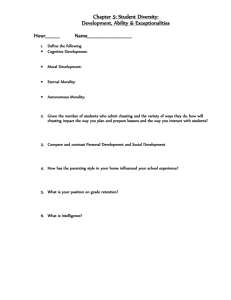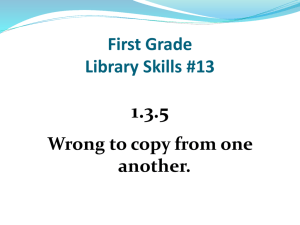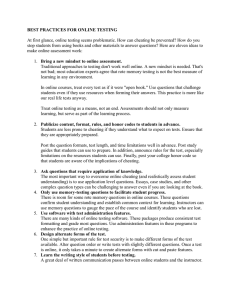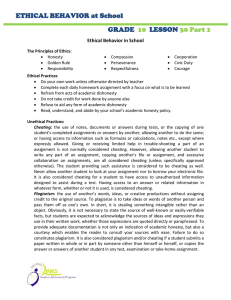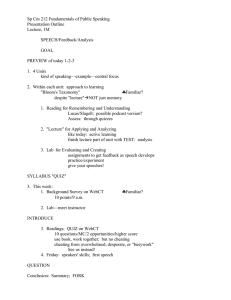Cheating vs. Helping GRADE LESSON
advertisement
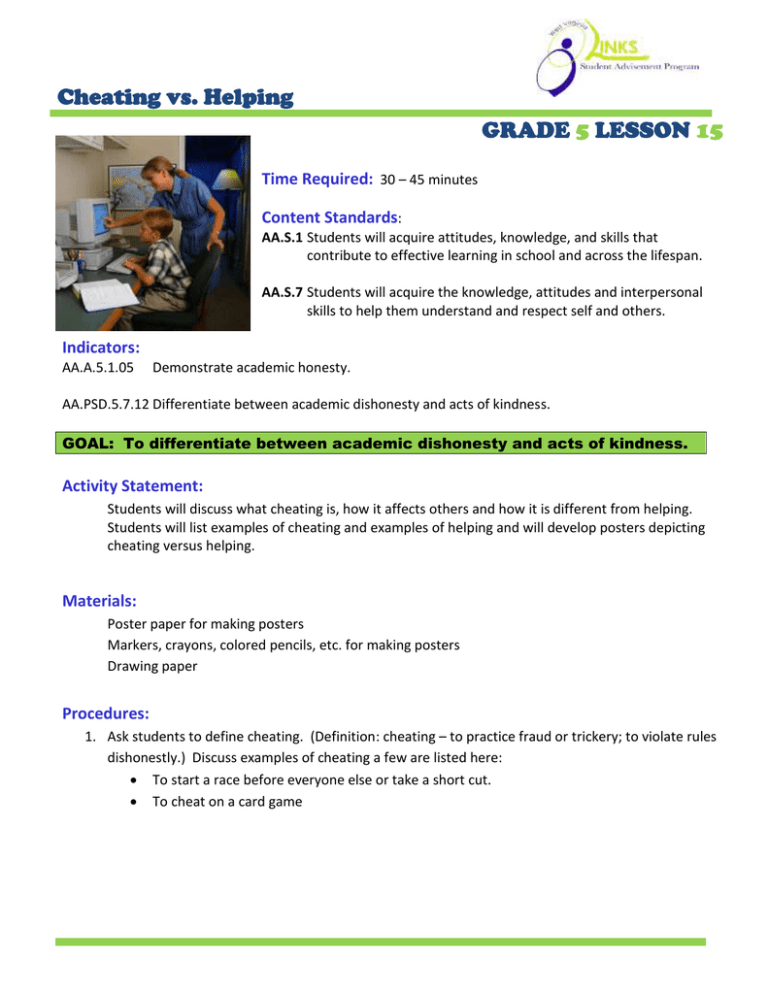
Cheating vs. Helping GRADE 5 LESSON 15 Time Required: 30 – 45 minutes Content Standards: AA.S.1 Students will acquire attitudes, knowledge, and skills that contribute to effective learning in school and across the lifespan. AA.S.7 Students will acquire the knowledge, attitudes and interpersonal skills to help them understand and respect self and others. Indicators: AA.A.5.1.05 Demonstrate academic honesty. AA.PSD.5.7.12 Differentiate between academic dishonesty and acts of kindness. GOAL: To differentiate between academic dishonesty and acts of kindness. Activity Statement: Students will discuss what cheating is, how it affects others and how it is different from helping. Students will list examples of cheating and examples of helping and will develop posters depicting cheating versus helping. Materials: Poster paper for making posters Markers, crayons, colored pencils, etc. for making posters Drawing paper Procedures: 1. Ask students to define cheating. (Definition: cheating – to practice fraud or trickery; to violate rules dishonestly.) Discuss examples of cheating a few are listed here: To start a race before everyone else or take a short cut. To cheat on a card game Cheating vs. Helping GRADE 5 LESSON 15 2. Ask students to define helping. (Definition: helping – to give assistance or support; to be of use or benefit) Discuss examples of helping. Help a friend with their homework To support a teacher by handing out papers. 3. Ask the students for examples of cheating in school. Copying answers from someone’s paper Erasing someone’s name from a paper and putting yours on it Stealing answers to an assignment from the teacher’s answer book Getting someone else to do your work 4. Have the students form groups of three or four. Give each group a sheet of drawing paper and a colored marker. Tell them to select someone to record the group’s ideas in large lettering on the paper. Say: Each group will write down three examples of cheating and how they could be turned in to helping instead, examples: Instead of copying answers from someone’s paper ask that person how or where they got the answers. Instead of getting someone else to do your work as if you can work together to complete an assignment. 5. Each group will need to pick one of the examples they came up with above and draw a poster comparing cheating to helping. They will then discuss their poster with the rest of the group and posters will be displayed in the room or hallway for others to see under the heading. Discussion Questions: How would you feel if someone cheated on a test and, after you studied all night, got a better grade than you? How do you feel when you help others? How would you feel if someone took your work and put his/her name on it? How do you feel when someone helps you? How do other forms of cheating hurt the community? the country? the world? How does helping others affect the school, community, country, etc. How does cheating hurt the cheater? "You get out of it what you put into it." How does this statement relate to cheating? Developed by: Iestyn J. Bright, Counselor, WVDE (2010) Cheating vs. Helping GRADE 5 LESSON 15 Additional Resources: www.charactercounts.org – Character education program www.educatinworld.com – Developed lesson plans to assist with teaching character Extension Activities (Optional): Have students either ask for or offer help. If students are struggling in a particular subject tell them to seek out help either from another peer, their teacher or an adult instead of cheating. If students have skills which others could use have them offer that skill. Discuss how this made them feel at a later session. Adapted from: Character Counts Good Ideas Book Developed by: Iestyn J. Bright, Counselor, WVDE (2010)
